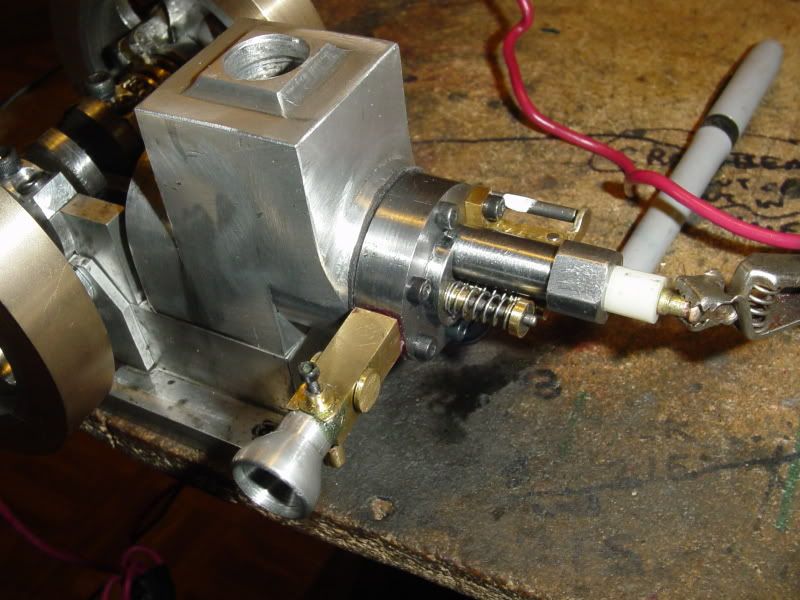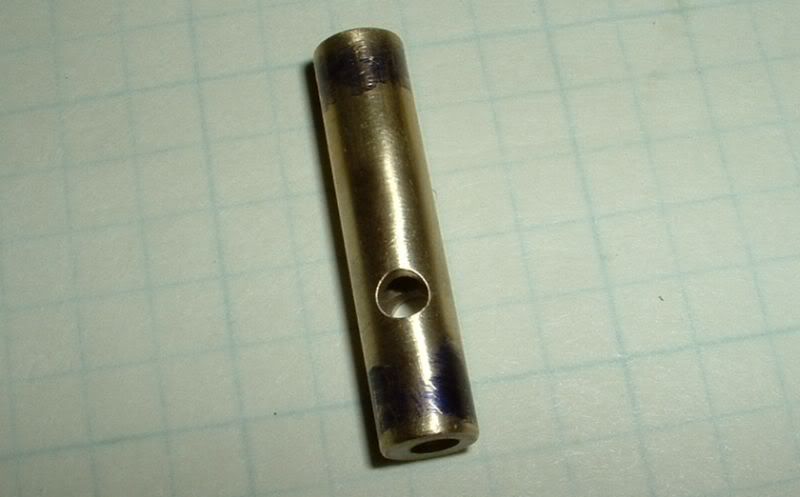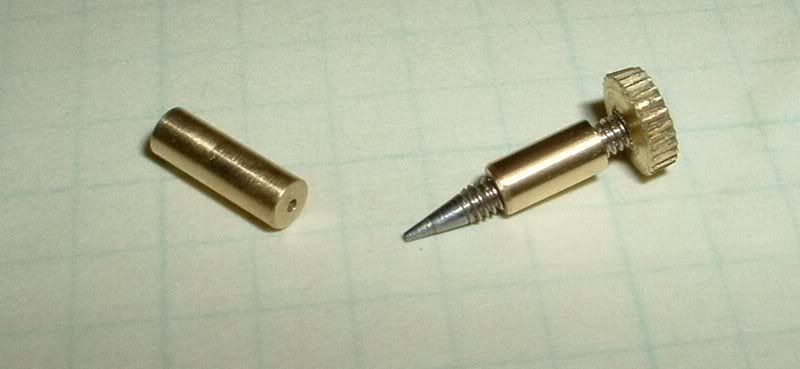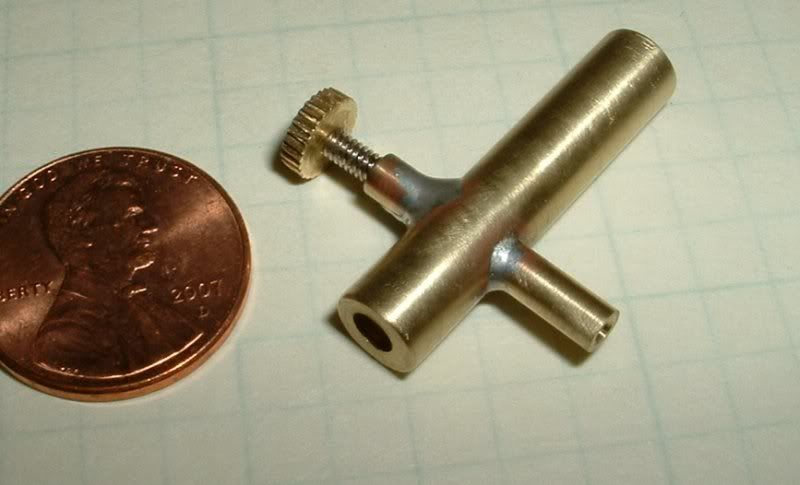You are using an out of date browser. It may not display this or other websites correctly.
You should upgrade or use an alternative browser.
You should upgrade or use an alternative browser.
Brian Builds the Kerzel Hit and Miss I.C.
- Thread starter Brian Rupnow
- Start date

Help Support Home Model Engine Machinist Forum:
This site may earn a commission from merchant affiliate
links, including eBay, Amazon, and others.
Brian, A lot of engines that were hit and miss just had a needle valve and it was mostly only the throttle (or volume) governed engines that had a butterfly, I reckon your on the right track with only a needle on a hit and miss emgine.
Thanks Lance
Thanks Lance
I have tamed the beast to the point where it will start and run fairly consistently---with Fairly being the key word here. I have had a few other far more experienced model engineers volunteer to me that the engine should run perfectly and consistently and start with a simple flick of the flywheels before even attempting to run it in hit and miss mode. Obviously, they are unaware of how I use my electric drill to crank the living snot out of it untill it starts to fire and run on its own!!! Now I am quite thrilled that it runs at all, and the issue at hand is that there are only 3 possible adjustments which can be made on the thing.---Ignition timing, valve timing, and screw the carburetor needle valve in or out. There seems to be a VERY narrow band of rotational deviation on the carb needle valve after which the engine just pukes and dies. It wants to run at a fairly low speed, which may not be fast enough to make the centrifugal weights fly out and do their thing---I'm not sure. The only way for me is to really be able to play with it repeatedly for the next week untill I decide what the optimum settings are and then go from there.
Brian - when I used to mess about with stationery engines, I can't remember those ever running perfectly or consistently! I know Gail spent a lot of time on his tiny fine tuning it so you may be able get some pointers there. he changed jet sizes and tapers of needles etc a lot. I remember him saying that too rich to too lean was a minute amount on the needle but he managed to make it less sensitive.
Keep fiddling, you'll improve matters.
Nick
Keep fiddling, you'll improve matters.
Nick
Common carburetors used on hit and miss engines require the needle to be set for the desired rpm. Carburetors designed to be used on throttlable engines are more complex and include some method to lean the mixture when throttling down. Some use and air bleed system which diverts some of the vacuum on idle or slow speed; others move the needle valve in and out with the throttle. Anyway, a hit and miss only needs to be adjusted for one rpm setting. I'm sure you know all this but just in case you haven't experienced a throttle type carb...
Maryak
Well-Known Member
- Joined
- Sep 12, 2008
- Messages
- 4,990
- Reaction score
- 77
Brian,
The only way I know to make a needle valve more sensitive is for the needle to fit into a matching taper in the valve body, not just throttle on the edge of a "normal" hole. Much easier to say than to do. Any way I thought it was worth mentioning as the general comment seems to be that without the sophistication of air bleeds, multiple jets etc, there's a fine line between go and no go. This may broaden the line somewhat.
Any way I thought it was worth mentioning as the general comment seems to be that without the sophistication of air bleeds, multiple jets etc, there's a fine line between go and no go. This may broaden the line somewhat.
Hope this helps.
Best Regards
Bob
The only way I know to make a needle valve more sensitive is for the needle to fit into a matching taper in the valve body, not just throttle on the edge of a "normal" hole. Much easier to say than to do.
Hope this helps.
Best Regards
Bob

$25.34
$34.99
Peachtree Woodworking Supply Bowl Sander Tool Kit w/Dual Bearing Head & Hardwood Handle, 42 Pieces Wood Sander Set, 2 Hook & Loop Sanding Disc Sandpaper Assortment, 1/4 Mandrel Bowl Sander
Peachtree Woodworking Supply Inc

$599.00
$649.00
FoxAlien Masuter Pro CNC Router Machine, Upgraded 3-Axis Engraving All-Metal Milling Machine for Wood Acrylic MDF Nylon Carving Cutting
FoxAlien Official

$2.08
$19.95
Sheds & Garages: Building Ideas and Plans for Every Shape of Storage Structure
goodwill_ind_of_mid_tn
Today I made a much longer more tapered needle valve and installed it in the carb. Surprisingly enough, it didn't seem to make any real difference. The carb has a VERY short distance form the air inlet to the needle valve and gas distribution tube, so I thought perhaps turbulence in the air stream might account for some of the fluctuation in engine speeds as it sets there running---I added an extension modelled after the old "velocity stacks" I had on my 1969 skidoo engine---made no difference. (Didn't see that blob of loctite on the side of the carb untill after I took the picture.)


Looking for a bit of guidance here from someone with personal experience with these very basic, simple carburetors---Needle valve only, no throttle. I am still "tweaking" my engine, trying to find its "sweet spot" so that I can carry on with getting it into hit and miss mode. Prior to this evening, I have played with the ignition timing, and with settings on the needle valve. the engine would run, and run continuously, but not at a high RPM and would frequently "stumble" as it ran, sometimes just running down and stopping for no particular reason. It would easily restart, but it didn't seem to operate consistently. This evening, having exhausted all of the possible settings on ignition timing and needle valve settings, I thought perhaps I would play a bit with the only adjustment left---the valve timing. I loosened off the setscrews which hold the small gear to the crankshaft, and turned it perhaps 5 degrees in the opposite direction to what the crankshaft normally turns. I THINK that slightly ******* the valve timing. (Correct me if I have that backwards). Anyways, the engine now races like a banshee, enough to be somewhat frightening, and the more I close the needle valve, the faster it wants to go---which gets really scary with all those open bits whizzing around. Now as much as I think that may be what I want for hit and miss mode to operate succesfully, I don't fully understand exactly whats happening here. If someone has a logical explanation, I would be very happy to hear it.---Brian
- Joined
- Jan 19, 2010
- Messages
- 1,193
- Reaction score
- 41
Brian, I think that retarding the timing is like putting a "Hot" cam in your car. Since the exhaust valve is opening sooner, there is more time for the hot gas to leave the cylinder. Since it is impossible to overlap the intake and exhaust valves I believe you have it set in the Ideal position for "Hit and Miss" mode.
I think you want the most power you can get for each power stroke, this will keep the flywheel spinning fast, and therefore "Miss" for more revolutions, leaving more space between the power strokes.
I Think :shrug:
Kel
I think you want the most power you can get for each power stroke, this will keep the flywheel spinning fast, and therefore "Miss" for more revolutions, leaving more space between the power strokes.
I Think :shrug:
Kel
It sounds like one of two things. Either the exhaust was becoming compressed slightly by late opening of the valve, or it opened too early wasting part of the power stroke. Either way, she sounds like she wants to run, and thats a good thing. You can always install a restrictor between the needle valve and intake to slow her down, speeding them up is harder. ;D
- Joined
- Dec 28, 2008
- Messages
- 1,731
- Reaction score
- 9
Maryak said:Brian,
The only way I know to make a needle valve more sensitive is for the needle to fit into a matching taper in the valve body, not just throttle on the edge of a "normal" hole. Much easier to say than to do.Any way I thought it was worth mentioning as the general comment seems to be that without the sophistication of air bleeds, multiple jets etc, there's a fine line between go and no go. This may broaden the line somewhat.
Hope this helps.
Best Regards
Bob
Bob, would it work for Brian to make a tapered hole (jet) using a tapered pin reamer, and machine a needle valve with the same taper?
-MB
G day Brian,
I dont have much model experience with the model engines but have had a fair bit to do with the full size engines.
It sounds like you are getting close to ideal with the timing and mixture, as the engine leans out they will pick up revs to a point.
The speed is then controlled by adjusting the tension on the governor springs, less tension means lower revs. As the flywheel slows the weight moves in and the engine fires,often by engaging the exhaust valve again, when the engine is going at the desired speed the engine gov weights throw out with centrifugal force and often holds the exhaust valve open so the engine slows until the governor senses it has slowed and engages the valve again and the firing takes it up to governed speed again.
The more the load on the engine the more often it will fire (trying to keep the speed up to the governed speed)
Clear as mud?
Lance
I dont have much model experience with the model engines but have had a fair bit to do with the full size engines.
It sounds like you are getting close to ideal with the timing and mixture, as the engine leans out they will pick up revs to a point.
The speed is then controlled by adjusting the tension on the governor springs, less tension means lower revs. As the flywheel slows the weight moves in and the engine fires,often by engaging the exhaust valve again, when the engine is going at the desired speed the engine gov weights throw out with centrifugal force and often holds the exhaust valve open so the engine slows until the governor senses it has slowed and engages the valve again and the firing takes it up to governed speed again.
The more the load on the engine the more often it will fire (trying to keep the speed up to the governed speed)
Clear as mud?
Lance
Kel, if he's retarding the cam, turning in oppopsite way to direction of running doesn't that mean the exhaust valve will open later?
If you do that you will also need to change ignition timing to suit presumably. Shame you can't alter the ignition timing whilst the engine is running, like on a car, turn the dizzy until the revs peak etc.
If you do that you will also need to change ignition timing to suit presumably. Shame you can't alter the ignition timing whilst the engine is running, like on a car, turn the dizzy until the revs peak etc.
- Joined
- Jul 16, 2007
- Messages
- 3,069
- Reaction score
- 1,209
Hi Nick,
I depends on what type of trigger you have for your ignition, points or Hall effect. On my version of 'Tiny' I mounted my Hall sensor on a movable arm that pivots around the crankshaft so that I could change my timing.
gbritnell
I depends on what type of trigger you have for your ignition, points or Hall effect. On my version of 'Tiny' I mounted my Hall sensor on a movable arm that pivots around the crankshaft so that I could change my timing.
gbritnell
Generatorgus
Senior Member
- Joined
- Feb 25, 2010
- Messages
- 362
- Reaction score
- 167
Brian, being a rookie and not having anything to ad, I've quietly watched your build from the get go and lost it for a while a couple of weeks ago,just when it was getting exciting. I picked up on it this morning.
Well done!!!! Your stick-to-it-ivness has given me the courage to go back to my shelved, in total frustration, Henry Ford 1/2 scale, my first and only build. It's been there over a year, it did run for a while and quit. I tried everything, new valves, even a cylinder and piston. Now, after your experience, I'm pretty sure it was the valves. I used the same grinding compond, and the seats are way too wide. I'm going to have another go at it.
Once again, well done, and thanks for a such well documented build, even the blunders and ****oos. Fascinating. :bow:
GUS
Well done!!!! Your stick-to-it-ivness has given me the courage to go back to my shelved, in total frustration, Henry Ford 1/2 scale, my first and only build. It's been there over a year, it did run for a while and quit. I tried everything, new valves, even a cylinder and piston. Now, after your experience, I'm pretty sure it was the valves. I used the same grinding compond, and the seats are way too wide. I'm going to have another go at it.
Once again, well done, and thanks for a such well documented build, even the blunders and ****oos. Fascinating. :bow:
GUS
Brian you could try making a carb with a smaller bore, or at least a smaller 'choke' where the needle valeve is. Could be the airspeed through the carb is too low. Another thing is the inlet valve spring might be holding the valve shut until very late in the stroke giving the valve a very short duration, so try a lighter spring on that too.
By winding the needle in you're leaning the engine out, pushing up exhaust gas temperatures which might be improving the cylinder scavenging thus giving better induction or simply leaning the mixture might be improving induction - lean running engines tend to race when not loaded and bog down under load anyway, but it's all speculation really given the many variables.
By winding the needle in you're leaning the engine out, pushing up exhaust gas temperatures which might be improving the cylinder scavenging thus giving better induction or simply leaning the mixture might be improving induction - lean running engines tend to race when not loaded and bog down under load anyway, but it's all speculation really given the many variables.
The spring I have in there now is lighter than a butterflies wing---but I have done a couple of experiments while the engine is running, using a very small screwdriver to lift the bottom of the spring and consequently putting more pressure on the spring. The engine immediately begins to burp and fart---doesn't like that even a little bit. If I go to a lighter spring, the engine isn't going to run because the valve won't close at all.
- Joined
- Jan 19, 2010
- Messages
- 1,193
- Reaction score
- 41
NickG said:Kel, if he's retarding the cam, turning in oppopsite way to direction of running doesn't that mean the exhaust valve will open later?
Nick, your absolutely right. I retract my former statement.
Kel
rudydubya
Well-Known Member
- Joined
- Nov 26, 2008
- Messages
- 337
- Reaction score
- 7
Brian, I'm not really qualified to give guidance, but here are a few pictues of a very basic, simple carburetor. My Upshur runs well with it. No machined venturi or complex jet. The body is just a piece of 1/4" brass rod with a hole suited to your engine size drilled down its length and then a hole through it for the needle valve assembly. The needle valve assembly is two pieces of brass rod, one with a hole down to within about 1/16" of the bottom, then a suitable sized hole for the needle valve seat. The other piece is drilled and tapped for a 2-56 screw needle, which is turned down on one end. Mine is about a 15 degree point. Then everything is soft-soldered together. Easy to make, or I couldn't have made it.Brian Rupnow said:Looking for a bit of guidance here from someone with personal experience with these very basic, simple carburetors---Needle valve only, no throttle.
The carburetor body. Yes, the hole down the middle is off center, not by design, it just happened. I did mention that I was a novice, didn't I?

The needle valve and jet.

Finished Carburetor. There's also a spring to keep the needle from vibrating loose, not shown.

And a view down the bore of the finished carburetor.

Rudy
Similar threads
- Replies
- 413
- Views
- 67K
- Replies
- 356
- Views
- 67K








































